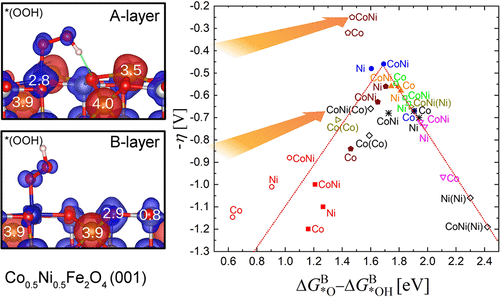当前位置:
X-MOL 学术
›
ACS Catal.
›
论文详情
Our official English website, www.x-mol.net, welcomes your feedback! (Note: you will need to create a separate account there.)
Surface Termination and Composition Control of Activity of the CoxNi1–xFe2O4(001) Surface for Water Oxidation: Insights from DFT+U Calculations
ACS Catalysis ( IF 11.3 ) Pub Date : 2018-10-29 00:00:00 , DOI: 10.1021/acscatal.8b00574 Hamidreza Hajiyani 1 , Rossitza Pentcheva 1
ACS Catalysis ( IF 11.3 ) Pub Date : 2018-10-29 00:00:00 , DOI: 10.1021/acscatal.8b00574 Hamidreza Hajiyani 1 , Rossitza Pentcheva 1
Affiliation

|
Using density functional theory calculations with an on-site Hubbard term (DFT+U), we explore the effect of surface termination and cation substitution on the performance of the CoxNi1–xFe2O4(001) surface (x = 0.0, 0.5, 1.0) as an anode material in the oxygen evolution reaction (OER). Different reaction sites (Fe, Co, Ni, and an oxygen vacancy) were investigated at three terminations: the B-layer with octahedrally coordinated Co/Ni and with an additional half and full monolayer of Fe (0.5A and A-layer, respectively). Ni substitution with an equal concentration of Co and Ni (x = 0.5) reduces the overpotential over the end members for the majority of reaction sites. Surface Co cations are identified as the active sites and the ones at the A-layer termination for x = 0.5 exhibit one of the lowest theoretically reported overpotentials of 0.26 V. The effect of the additional iron layer on the active site modification is 2-fold: analysis of the electronic properties and spin densities indicates that the additional Fe layer stabilizes a bulk-like oxidation state of +2 for Co and Ni at the A-layer termination, whereas at the B-layer termination, they are oxidized to 3+. Moreover, the unusual relaxation pattern enables the formation of a hydrogen bond of the OOH intermediate to a neighboring surface oxygen that lowers the reaction free energy of this formerly rate-limiting step, leading to a deviation from the scaling relationship and almost equidistant reaction free-energy steps of intermediates. This renders an example of how a selective surface modification can result in a significant improvement of OER performance.
中文翻译:

用于水氧化的Co x Ni 1– x Fe 2 O 4(001)表面的表面终止和活性控制:从DFT + U计算得出的见解
使用现场哈伯德项(DFT + U)的密度泛函理论计算,我们探索了表面终止和阳离子取代对Co x Ni 1– x Fe 2 O 4(001)表面性能的影响(x = 0.0 ,0.5、1.0)作为氧气逸出反应(OER)中的阳极材料。在三个端点处研究了不同的反应位点(Fe,Co,Ni和氧空位):具有八面体配位的Co / Ni的B层以及另外一半和完全的Fe单层(分别为0.5A和A层) )。用等浓度的Co和Ni替代Ni(x= 0.5)减少了大多数反应位点的末端成员上的过电势。表面Co阳离子被标识为活性位点,在x的A层终端处被标识为= 0.5表示理论上最低的过电势之一,为0.26V。附加铁层对活性位点修饰的影响是2倍:对电子性能和自旋密度的分析表明,附加铁层稳定了块状Co和Ni在A层终端处的氧化态为+2,而在B层终端处,它们被氧化为3+。此外,异常的弛豫模式使OOH中间体与相邻的表面氧形成氢键,从而降低了该先前限速步骤的反应自由能,从而导致与比例关系发生偏离,并且反应自由度几乎等距。中间体的能级。
更新日期:2018-10-29
中文翻译:

用于水氧化的Co x Ni 1– x Fe 2 O 4(001)表面的表面终止和活性控制:从DFT + U计算得出的见解
使用现场哈伯德项(DFT + U)的密度泛函理论计算,我们探索了表面终止和阳离子取代对Co x Ni 1– x Fe 2 O 4(001)表面性能的影响(x = 0.0 ,0.5、1.0)作为氧气逸出反应(OER)中的阳极材料。在三个端点处研究了不同的反应位点(Fe,Co,Ni和氧空位):具有八面体配位的Co / Ni的B层以及另外一半和完全的Fe单层(分别为0.5A和A层) )。用等浓度的Co和Ni替代Ni(x= 0.5)减少了大多数反应位点的末端成员上的过电势。表面Co阳离子被标识为活性位点,在x的A层终端处被标识为= 0.5表示理论上最低的过电势之一,为0.26V。附加铁层对活性位点修饰的影响是2倍:对电子性能和自旋密度的分析表明,附加铁层稳定了块状Co和Ni在A层终端处的氧化态为+2,而在B层终端处,它们被氧化为3+。此外,异常的弛豫模式使OOH中间体与相邻的表面氧形成氢键,从而降低了该先前限速步骤的反应自由能,从而导致与比例关系发生偏离,并且反应自由度几乎等距。中间体的能级。











































 京公网安备 11010802027423号
京公网安备 11010802027423号